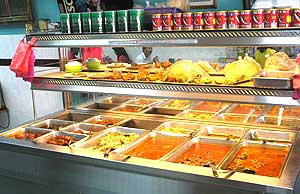We have come across one too many food poisoning cases in schools since May this year, as reported by the local dailies.
Just to recap, in May 2007, 100 students of a Tamil school in Klang suffered food poisoning after eating nasi lemak. Then, there was the case of spoilt milk given to children under the school milk programme. In June 2007, students of Sekolah Kebangsaan Tandop Besar, Kuala Nerang and 115 students of Sekolah Menengah Kebangsaan Ayer Hitam also suffered food poisoning followed by another case of food poisoning in Kelantan, after that.
We cannot sit on our laurels and risk the lives of sensitive groups of the population or even teenagers. We need not wait for a casualty of food poisoning before the relevant authorities take concrete action to eradicate poor quality and unsafe food served to anyone in Malaysia more so students. We need integrated and proactive measures from government, industry (food producers, handlers) and the community.
What is food poisoning?
 Food poisoning is a result of the intake of food contaminated with dangerous bacteria (germs) or their toxins. Dangerous bacteria are also known as pathogens. Food poisoning can be classified as mild and serious. Mild food poisoning results in few episodes of vomiting and diarrhoea which will later subside. Serious food poisoning results in continuous vomiting, diarrhoea or bloody diarrhoea, fever leading to severe dehydration. E.coli O157:H7 leads to bloody diarrhoea, and occasionally to kidney failure and sometimes death.
Food poisoning is a result of the intake of food contaminated with dangerous bacteria (germs) or their toxins. Dangerous bacteria are also known as pathogens. Food poisoning can be classified as mild and serious. Mild food poisoning results in few episodes of vomiting and diarrhoea which will later subside. Serious food poisoning results in continuous vomiting, diarrhoea or bloody diarrhoea, fever leading to severe dehydration. E.coli O157:H7 leads to bloody diarrhoea, and occasionally to kidney failure and sometimes death.
What are the main pathogens causing food poisoning?
There are few types of pathogens which cause food poisoning or contaminate food with their toxins. These are: Salmonella, E-coli and Listeria.
Most of these bacteria are present in animal based products or produce like meat, fish, egg and milk. The high protein content makes these types of food easily contaminated and results in food poisoning if not cooked properly and consumed. They may also cross contaminate other food which is already cooked if the same utensils are used for both without washing them properly.
What are the symptoms?
As mentioned before the symptoms of food poisoning include but not limited to:
1) Nausea
2) Vomiting
3) Abdominal cramps
4) Diarrhoea
5) Fever
Normally the symptoms manifest an hour to two after consumption of contaminated food. Serious food poisoning may manifest earlier than that.
What causes food poisoning?
If we observe the media reports, most of the food poisoning cases involve many victims at once. This does not mean an individual or two do not get food poisoning. But in almost all the cases of food poisoning the food in question is prepared by someone else or somewhere else, always outside their homes. The foods are also prepared commercially and in large quantities.
Food handlers and mass caterers who do not follow food hygiene practices allow food to be contaminated and when consumed by their customers results in food poisoning.
Do you know that there are principles to comply with to ensure that food prepared by mass caterers is safe for consumption?
This set of principles is published as Malaysian Standards titled MS 1514:2001: General Principles of Food Hygiene. There are appropriate Malaysian Standards for food manufacturers too, called the Good manufacturing Practices or GMP. Both these standards are developed based on international standards such as Codex Alimentarius or ISO.
General principles of food hygiene
The General Principles of Food Hygiene outlines safe food preparation. Among the aspects covered under the principles are:
1. Premise Hygiene:
a. External hygiene free from bushes, discourage breeding of pests such as rats. It includes proper drainage system free for water to flow or free of clogs.
b. Internal Hygiene no cracked tiles, designated store for raw materials separate from cooked food. Separate storage for vegetables and fruits from animal based raw materials such as fresh meat, eggs and poultry.
2. Pest control and management - use of licensed pesticide control service providers who use pesticides allowed by law for use in food preparation premises.
3. Hygiene Principles Awareness Training continuous and periodically.
a. Workers hygiene cap or hair restrainers, apron, clean fingernails and no ring etc.
b. The worker who comes in contact with food directly must not be allowed to do cleaning or sanitation at the same time (like mopping, sweeping, washing utensils etc)
4. Use of safe cleaning detergents use of dangerous bleaching agents like chlorine, for example is not allowed.
5. Ready to eat or serve food must be stored in a clean place and if temperature control is required (like warmer or chiller) it must be maintained as required.
6. Raw materials sensitive to contamination must be kept under controlled temperature (like a freezer). Refrigerators must be maintained properly to avoid big fluctuations in temperature which will allow the growth of pathogens.
Who develops food safety standards?
The Department of Standards Malaysia develops Malaysian Standards (MS) for all kinds of practices, products, processes, guidelines, performances etc. The use of the MS 1514:2001 helps consumers to compare facilities, quality and safety of food prepared by restaurants, canteens and cafeterias. MS 1514:2001 can also be used as a tool by the Ministry of Health, local governments, parties giving out canteen operation tenders, the schools, state and district education departments to monitor and maintain safe food preparation at school canteens.
The Ministry of Health is a standards writing organisation and participates in the standards development activities by the Department of Standards Malaysia.
For the benefit of the reader, Standards Malaysia is the national standards and accreditation body under the Ministry of Science, Technology and Innovation. To date the department has developed more than 4500 Malaysian Standards.
What are the issues and obstacles against tackling food poisoning?
1. Varying sets of hygiene requirements used by local governments
 Have you seen the premise grades certifications displayed by restaurants, where they claim that a particular restaurant is an A premise or a B premise and so on? The certificate is awarded by local governments to restaurants which fulfil a set of food preparation requirements developed by the local government with or without consultation from the Ministry of Health.
Have you seen the premise grades certifications displayed by restaurants, where they claim that a particular restaurant is an A premise or a B premise and so on? The certificate is awarded by local governments to restaurants which fulfil a set of food preparation requirements developed by the local government with or without consultation from the Ministry of Health.
A comparison of requirements between three local governments (in Klang Valley) was carried out by the Malaysian Association of Standards Users (Standards Users) and discovered that the requirements are not consistent. The requirements for an A premise in Subang Jaya may be used for a B premise in Klang, perhaps.
We need to ask, why isn't the MS 1514:2001 used since it was developed in accordance with the Standards Act of Malaysia 1996? Aren't the local governments aware of the standards?
2. Lack of awareness and overlapping of jurisdiction over food products by two separate ministries.
Following the safety problems with school milk programme, the Minister of Education ordered that all milk supplied for the programme be approved by SIRIM.
It is incorrect to request approval from an organisation which operates as a private entity. The right party to do so is the Food Safety and Quality Division of the Ministry of Health or the Department of Veterinary Services (DVS). DVS is an agency under the Ministry of Agriculture and Agro-base Industry. DVS has already certified many producers of milk products in Malaysia. Their certification programme includes compliance with HACCP.
HACCP is a food safety management system which is product specific. The title designated for HACCP requirement under the Malaysian Standards is MS 1480:2007.
We urge that the Food Safety and Quality Division include in the Food Regulations 1985 that:
a) All food products intended for consumption of sensitive population: children, elderly and pregnant mothers be required to comply with HACCP requirements.
b) All milk and other animal-based products to comply with the DVS certification requirements.
c) Ensure product recall programme is outlined clearly as a mandatory requirement for all food manufacturers, distributors, wholesalers etc. (all in the food supply chain)
3. Database on food poisoning or safety incidents is not comprehensive
Standards Users believe that the report on food poisoning or food safety incidences is not comprehensive and does not represent the extent of which it occurs.
Most of the victims of mild food poisoning rarely report the incident. They go to the pharmacy to get some prescriptions for their diarrhoea or vomiting. Those with severe food poisoning who visit the general practitioners (GPs) also do not report the incident and neither do the GPs. Then again, who knows the hotline to report food safety incidences or poisoning?
4. Awareness on the importance of food hygiene
Children or students who are taught importance of food hygiene in class go to their canteens for break where food may be prepared in a poor hygienic condition. Who checks the cleanliness of the canteens and based on what standards? If you look at some of the sinks or hand wash basin in some school canteens, they are poorly maintained. No soap is provided for the students to clean their hands before meal.
Are there currently requirements for canteen operators to attend periodic food hygiene training? Are these requirements clearly specified in the tender process/ offers?
Since the state or district education department and the headmasters are involved in the tender process for canteen operators they must at least ensure that the principles of MS 1514:2001 are complied with. The parties mentioned above should also ensure that there is a mechanism to ensure the safety and quality of food prepared at the canteens are maintained.
Important responsibility
We are all responsible to ensure that children are brought up in an environment where they appreciate clean and healthy food. Parents should discourage themselves and their children from eating at unhygienic food outlets and eating unhealthy food.
 Schools have an important responsibility to ensure that children who come to enhance their quality of life are not exposed to dangers of food poisoning.
Schools have an important responsibility to ensure that children who come to enhance their quality of life are not exposed to dangers of food poisoning.
Industry must not seek to escape from complying with basic hygiene requirements. Food is the third most important aspect of survival after air and water. It is the responsibility of the food handlers and producers and all in the supply chain to ensure only safe food reach the market.
The government has the role of putting in place policies to clearly discourage the preparation and production of unsafe food. They should also impose policies to recall unsafe food placed in the market and severely punish and publicise wrong doers.
The above are many social responsibilities of the different stakeholders in the food supply chain.
RATNA DEVI NADARAJAN is director, Malaysian Association of Standards Users.

